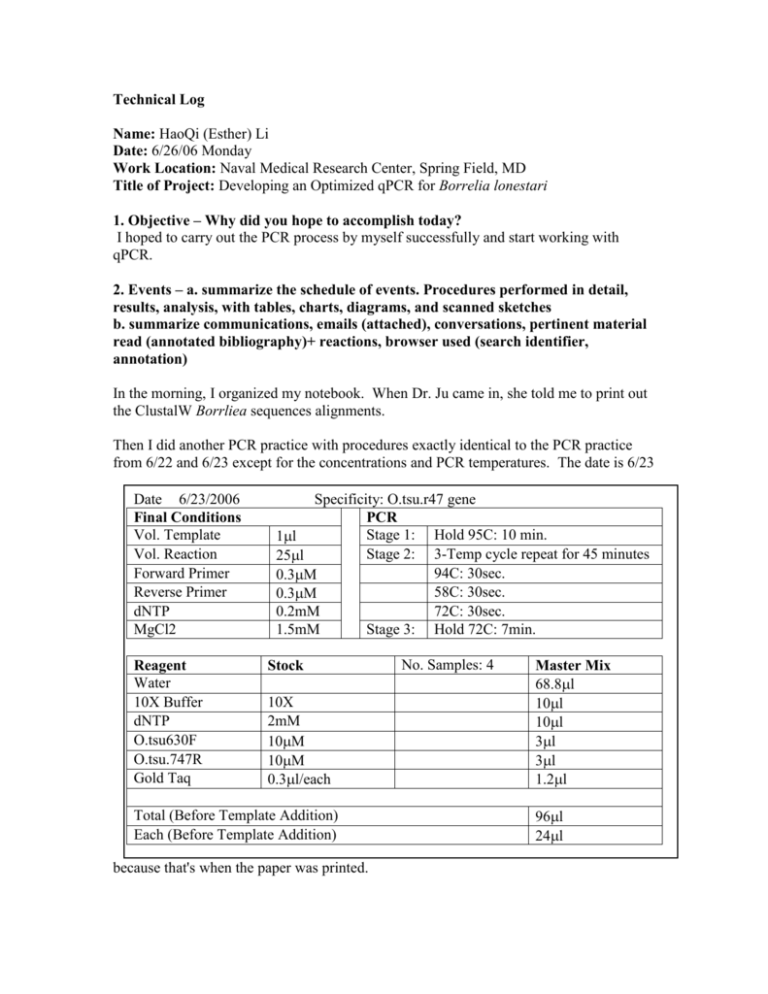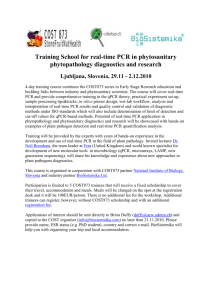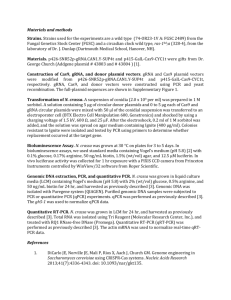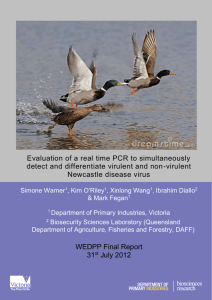Log062606EDIT
advertisement

Technical Log Name: HaoQi (Esther) Li Date: 6/26/06 Monday Work Location: Naval Medical Research Center, Spring Field, MD Title of Project: Developing an Optimized qPCR for Borrelia lonestari 1. Objective – Why did you hope to accomplish today? I hoped to carry out the PCR process by myself successfully and start working with qPCR. 2. Events – a. summarize the schedule of events. Procedures performed in detail, results, analysis, with tables, charts, diagrams, and scanned sketches b. summarize communications, emails (attached), conversations, pertinent material read (annotated bibliography)+ reactions, browser used (search identifier, annotation) In the morning, I organized my notebook. When Dr. Ju came in, she told me to print out the ClustalW Borrliea sequences alignments. Then I did another PCR practice with procedures exactly identical to the PCR practice from 6/22 and 6/23 except for the concentrations and PCR temperatures. The date is 6/23 Date 6/23/2006 Final Conditions Vol. Template Vol. Reaction Forward Primer Reverse Primer dNTP MgCl2 Reagent Water 10X Buffer dNTP O.tsu630F O.tsu.747R Gold Taq Specificity: O.tsu.r47 gene PCR Stage 1: Hold 95C: 10 min. 1l Stage 2: 3-Temp cycle repeat for 45 minutes 25l 94C: 30sec. 0.3M 58C: 30sec. 0.3M 0.2mM 72C: 30sec. 1.5mM Stage 3: Hold 72C: 7min. Stock 10X 2mM 10M 10M 0.3l/each Total (Before Template Addition) Each (Before Template Addition) because that's when the paper was printed. No. Samples: 4 Master Mix 68.8l 10l 10l 3l 3l 1.2l 96l 24l There were three lanes of plasmid Ktr47 DNA again: the negative control with no DNA, the 103copies/l in Tube A, and the 105copies/l in Tube B, exactly like last time. When the DNA samples were being amplified in the PCR machine, all of the Rickettsia Department’s SEAP students went to meet Dr. Richards, the department chair, who just returned from abroad. Dr. Richards helped us to understand our projects by answering questions. For my project, he explained that Borrelia is not Rickettsia and they are not related at all other than that ticks transmit them both. Thus I’m working in the Rickettsia Department but on a project that deals with Lyme disease!!! http://en.wikipedia.org/wiki/Lyme_disease and http://www.aldf.com/lyme.shtml have a nice overview of Lyme disease. Here is a picture of the lone star tick, which can carry the spirochete (spiral shaped) bacteria Borrelia lonestari. http://www.aldf.com/images/img-Lone-star-tick.jpg [///Things I learned for Rebecca’s project. Dr. Richards explained how ELISA (enzyme-linked immunosorbent assay) worked, which can be found http://en.wikipedia.org/wiki/ELISA. (I <3 Wikipeida!!!) For Rebecca’s specific project, the Rickettsia typhi is going to be put in and attached to the special protein attractive tube. Then in turn its antibody is added so, and finally an anti-human-antibody (i.e. produced in another animal) is added. When the enzyme ABTS 2,2'-azino-bis(3-ethylbenzthiazoline-6-sulphonic acid) and hydrogen peroxide H2O2 are added to this long chain of proteins and antibodies, the enzyme ABTS breaks apart and becomes green. Sometimes when a disease produces a lot of antibodies, the ELISA can be used but instead of first adding a protein (IgM, IgG, IgA, IgD, or IgE), the antibody is directly added on and a protein can be attached secondly. However for Rickettsia, most of the bacteria migrates through the endothelial (blood vessel) cells so not a significant amount is found in the blood stream. ///] After a short lunch, we finished up the second PCR practice. Unfortunately, the DNA ran off the gel. I observed the mentor’s aid Joey doing a real time PCR, i.e. qPCR. Everything is the same as the PCR, except for the concentration number, some reagent, and the machine and tubes used to amplify the PCR. Date 6/26/2006 Final Conditions Vol. Template Vol. Reaction Forward Primer Reverse Primer Probe dNTP MgCl2 Platinum Taq Reagent SuperMix-UDG Water O.tsu630F O.tsu.747R FAM Probe MgCl2 Specificity: O.tsu 1l 25l 0.1M 0.1M 0.2M 0.2mM 5mM 0.75 U Stock 2X(w/ Mg 3mM) 10M 10M 10M 50M Total (Before Template Addition) Each (Before Template Addition) No. Samples: 4 Master Mix 50l 38l 1l 1l 2l 4l 96l 24l Then just like the regular PCR, three 24l are taken out and put in special qPCR tubes with lenses at the bottom. After the addition of 1l of either water or O.tsu DNA, the three tubes are placed in the special qPCR machine and the qPCR program is turned on. After setting the program to read the specific three tubes and entering in the information about the three tubes, the qPCR process was started and the lines began to show after a few minutes. At first, all three tubes have values above the "threshold" (which means "positive"), but after 15 minutes the machine adjusted the values and all three lines fell to 0 as normal for before having been massively multiplied. We will take the results tomorrow. ---A flood warning was distributed and 3" of rain was expected by 5pm (didn't happen), so the commanders gave out the "59 minutes" warning so that people can leave early. ("59 minutes" because it is less than an hour, which is okay for a work day). 3. Reflections a. actually accomplished: I practiced PCR all by myself and I watched Joey perform qPCR. b. concerns: I should really start on my proposal!!! c. learning (workplace, science, project, yourself): I learned that Borrelia is NOT Rickettsia even though I'm working in the Rickettsial Department. I also learned about ELISA. I had a basic understanding of qPCR. 4. Planning I hope to do PCR more flawlessly tomorrow and perform a qPCR all by myself. I also hope to analyze the ClustalW Borrelia sequences with Dr. Ju. signature







